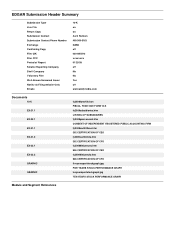NVIDIA 2008 Annual Report Download - page 12
Download and view the complete annual report
Please find page 12 of the 2008 NVIDIA annual report below. You can navigate through the pages in the report by either clicking on the pages listed below, or by using the keyword search tool below to find specific information within the annual report.
Sales and Marketing
Our worldwide sales and marketing strategy is a key part of our objective to become the leading supplier of performance GPUs, MCPs, and applications
processors that support netbooks, PNDs, PMPs, PDAs, cellular phones and other handheld devices. Our sales and marketing teams work closely with each
industry
’
s respective OEMs, ODMs, system builders, motherboard manufacturers, add
-
in board manufacturers and industry trendsetters, collectively referred to
as our Channel, to define product features, performance, price and timing of new products. Members of our sales team have a high level of technical expertise and
product and industry knowledge to support the competitive and complex design win process. We also employ a highly skilled team of application engineers to
assist our Channel in designing, testing and qualifying system designs that incorporate our products. We believe that the depth and quality of our design support
are keys to improving our Channel
’
s time
-
to
-
market, maintaining a high level of customer satisfaction within our Channel and fostering relationships that
encourage customers to use the next generation of our products.
In the GPU and MCP segments we serve, the sales process involves achieving key design wins with leading OEMs and major system builders and
supporting the product design into high volume production with key ODMs, motherboard manufacturers and add
-
in board manufacturers. These design wins in
turn influence the retail and system builder channel that is serviced by add
-
in board and motherboard manufacturers. Our distribution strategy is to work with a
number of leading independent contract equipment manufacturers, or CEMs, ODMs, motherboard manufacturers, add
-
in board manufacturers and distributors
each of which have relationships with a broad range of major OEMs and/or strong brand name recognition in the retail channel. In the CPB segment we serve, the
sales process primarily involves achieving key design wins directly with the leading handheld OEMs and supporting the product design into high
-
volume
production. Currently, we sell a significant portion of our processors directly to distributors, CEMs, ODMs, motherboard manufacturers and add
-
in board
manufacturers, which then sell boards and systems with our products to leading OEMs, retail outlets and to a large number of system builders.
Although a small number of our customers represent the majority of our revenue, their end customers include a large number of OEMs and system builders
throughout the world. As a result of our Channel strategy, our sales are focused on a small number of customers. Sales to our largest customer, Hewlett
-
Packard
Company, accounted for 11% of our total revenue for fiscal year 2009.
To encourage software title developers and publishers to develop games optimized for platforms utilizing our products, we seek to establish and maintain
strong relationships in the software development community. Engineering and marketing personnel interact with and visit key software developers to promote and
discuss our products, as well as to ascertain product requirements and solve technical problems. Our developer program makes certain that our products are
available to developers prior to volume availability in order to encourage the development of software titles that are optimized for our products.
Backlog
Our sales are primarily made pursuant to standard purchase orders. The quantity of products purchased by our customers as well as our shipment
schedules are subject to revisions that reflect changes in both the customers
’
requirements and in manufacturing availability. The semiconductor industry is
characterized by short lead time orders and quick delivery schedules. In light of industry practice and experience, we believe that only a small portion of our
backlog is non
-
cancelable and that the dollar amount associated with the non
-
cancelable portion is not significant. Consequently, we do not believe that a backlog
as of any particular date is indicative of future results.
Dependence on PC market
We derive and expect to continue to derive the majority of our revenue from the sale or license of products for use in the desktop PC and notebook PC
markets, including professional workstations. A reduction in sales of PCs, or a reduction in the growth rate of PC sales, may reduce demand for our
products. Changes in demand for our products could be large and sudden. During fiscal year 2009, sales of our desktop GPU products decreased approximately
29% compared to fiscal year 2008. These decreases were primarily due to the Standalone Desktop and Standalone Notebook GPU market segment decline as
reported in the PC Graphics December 2008 Report from Mercury Research. Since PC manufacturers often build inventories during periods of anticipated growth,
they may be left with excess inventories if growth slows or if they incorrectly forecast product transitions. In these cases, PC manufacturers may abruptly suspend
substantially all purchases of additional inventory from suppliers like us until their excess inventory has been absorbed, which would have a negative impact on
our financial results.
9
























